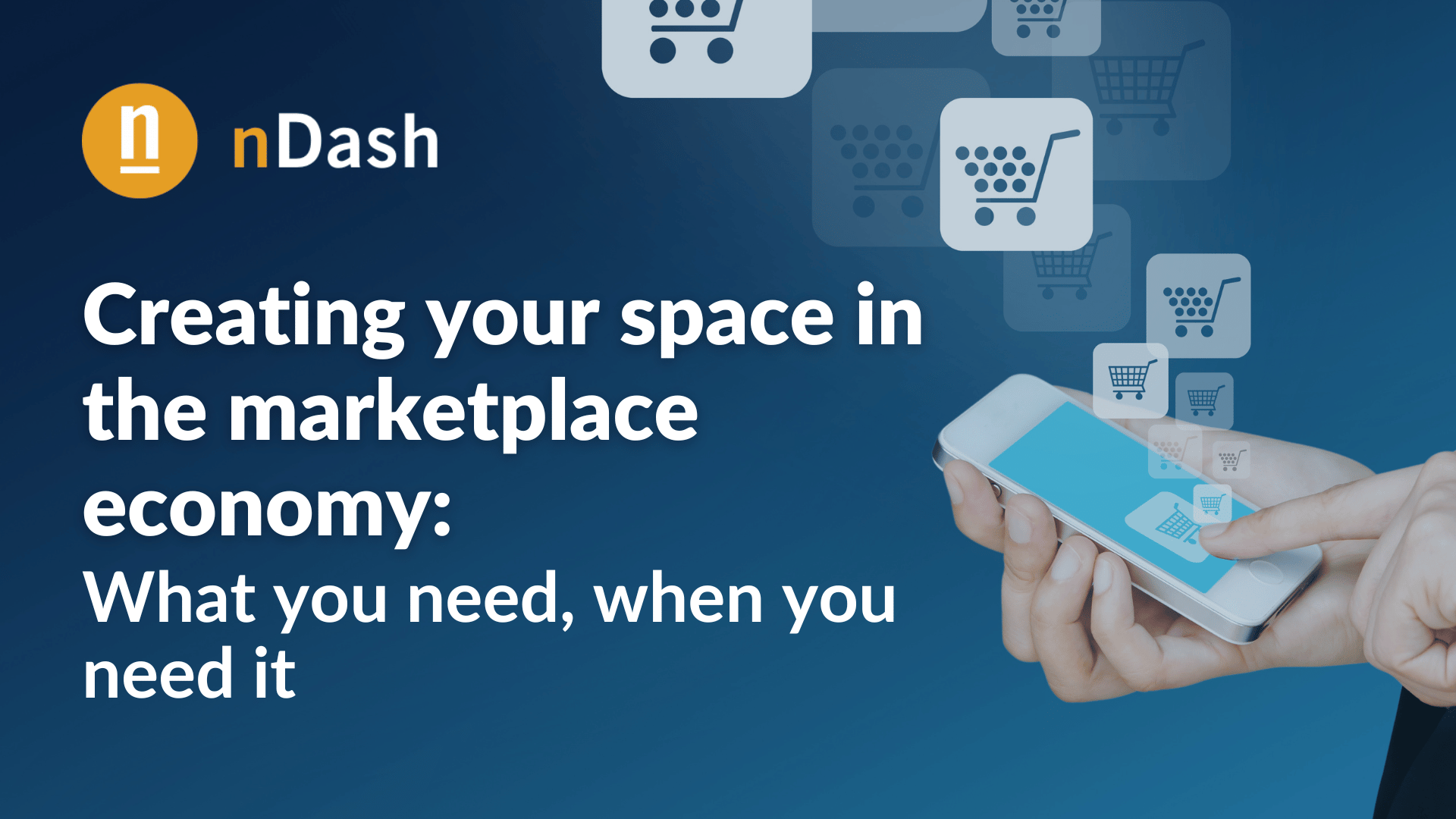What is a marketplace economy? This guide uncovers what factors gave way to this, how to build one that works and other key takeaways.
Disruptions force changes to sales models and give way to the marketplace economy
Not too many years ago, sales cycles could last weeks, months, or even years, especially in industries like IT and manufacturing. Sales teams were roadshows, making the same presentation to increasingly important people until they eventually reached the decision-makers.
Then, several things happened that turned that sales model upside down:
- The saturation of the enterprise-level market: Once the opportunities to sell to large organizations dwindled, businesses started targeting small and medium organizations. They quickly realized that they couldn’t continue high-investment sales practices when the potential profits were so much smaller. It was “change or die” time. They needed faster, less expensive sales processes, and they needed them now.
- Technology: Not only did technology make it possible to shorten sales cycles – think PowerPoint presentations and Zoom meetings rather than flying across the country to present your pitch to a client – it allowed the frontline folks (the ones who would actually use the product) to connect with each other and with vendors. Previously, it wasn’t uncommon for a purchasing department to buy software without even consulting the people in IT. Now, users are able to find the providers and products they wanted and pass that information on to Purchasing.
- COVID: With both buyers and sellers locked down at home, everyone had to come up with a new way to work. Technology was the fuel that kept the economy running.
- The gig economy: Not only did technology help shorten sales cycles, but it also helped shorten “jobs.” The gig economy – using your skill sets with multiple assignments and multiple clients instead of working for just one company – started long before COVID (you’ve heard the term “digital nomad”?). But COVID took it mainstream and made it a permanent part of today’s employment structure.
All of those factors contributed to the birth of a new way to get work done – the marketplace economy.
The rise of the marketplace economy
A “marketplace” is a website where businesses and providers can connect. (nDash, of course, is my favorite example of a marketplace!) It’s almost a hack: You can search based on whatever criteria you want, and you can read all about a prospect before you make contact, letting you willow out the ones that aren’t a good fit, saving time, and sparing yourself a string of follow-up emails!
While a lot of brands and creators form long-term relationships from these connections, it’s particularly useful for one-offs and other small projects. It’s also helpful when brands aren’t ready to commit to a particular marketing campaign. Agility is part of nDash’s DNA. Our creators allow brands to turn on a dime, try something new just to see if it works, or respond to events taking place in the world that are important to them or their customers.
How to build a marketplace that works
nDash was fortunate enough to get into the marketplace economy at just the right time. Moreover, nDash used to be a marketing agency, so we already had relationships with both clients and creators we could count on to “seed” our initiative. Nonetheless, we had a lot to learn, and I credit those lessons with getting us where we are today. nDash clients and creators are thriving. So I’d like to share some of the decisions we had to make and the lessons we learned. If you’re thinking about starting a marketplace site – or you already have one that’s struggling – I hope this helps.
Decide what kind of marketplace you want to create
Marketplace websites aren’t just for brands and creatives.
- Product marketplaces: I’m not talking about the Amazons of product marketplaces. I’m talking about the ones that directly connect buyers and sellers, especially for resale. eBay was the pioneer, but it was only the first of many to hit it big.
- Rentals: From AirBnB to Rent the Runway, rental marketplaces are booming.
- Services: Websites like Fiverr aren’t just for writers. You can find people offering everything from psychic readings to spell casting to logo design to cybersecurity and data protection.
Marketplaces might not work for every business, but if your costs are up or your sales declining, you need to tweak your strategy, and this is something worth thinking about.
Decide how you want to make money
Most marketplaces make money by taking a cut of the proceeds from each transaction or by charging a subscription fee to participate (or both). Ad revenue is another possibility. We’ll come back to this when we talk about who you’ll recruit first – buyers or sellers.
Decide how involved you want to be
This is probably the most important decision you’ll make. In fact, most of the other decisions you read about here will flow from your answer to this one.
- Do you want to be hands-on, vetting and onboarding both buyers and sellers?
- Do you want to have mandated price ranges?
- Do you want to do regular check-ins to find out how things are going for both buyers and sellers?
- Do you want to get involved in conflict resolution?
Or…do you want to set up the website, integrations, and APIs you’ll need and then just let things rip?
Set up the technical stuff
This includes things like choosing your platform, your CMS, your payment processor, your cybersecurity provider, etc. It’s also a good idea to have a knowledgeable person review your website before you roll it out to make sure it meets requirements set by the GDPR, the ADA, the W3C consortium, etc.
Be very clear about who your clients and providers are
I’m going to approach this from a content marketing angle since that’s what I know, but the question is relevant for any marketplace site. We decided very early on that we wanted nDash to be a place where elite writers could offer their services at fair prices (unlike the guy on Fiverr who’s offering to write a 1500-word, SEO-optimized article in 24 hours for $10). We didn’t want to be the cheapest; we wanted to be the best. And that answered the question of what kind of writers we wanted to recruit.
It also answered the question of what kind of clients we wanted to recruit. We wanted to attract brands that understood the value of top-notch writing and were willing and able to pay for it. At a time when many gig marketplaces were in a race to the bottom – offering services for ridiculously low prices — we decided to go with quality and the prices that came with it.
Decide who you want to reach out to first
As I mentioned before, we were lucky. We already had good relationships with both brands and creators. But we wanted to grow, and that meant deciding whether our initial focus would be on brands or writers. Since we had already decided to be writer-centric, it made sense to build the talent side of the equation first. And the writers we talked to were thrilled at the opportunity to get out of the self-defeating loop of trying to be the lowest bidder – and to work with an organization that understands writers as well as the capital value of their work. It was kind of a “build it and they will come” strategy.
At the same time, of course, we were reaching out to our brand contacts and letting them know what we were doing. We also ran social media and marketing campaigns that would appeal to both audiences.
I do need to mention, however, that your choice of how you’ll make money comes into play here. If you go with a subscription-based model, you might have trouble convincing folks on either side of the transaction to pay a subscription fee before you reach that critical mass that makes things start spinning. In that case, you might want to consider a “first six months free” incentive (or something like that) to overcome any resistance people may have to pay a subscription fee before they start making money.
Decide how you want buyers and sellers to interact with each other
Prior to nDash, most content marketing companies set up impenetrable walls between brands and writers. They did it to protect their income stream, fearing that if writers and brands could connect, they might just leave the platform and work with each other directly. But it created a lot of frustration: If a writer had a question, they had to go through a program manager who would reach out to the client. And the client had to go through that same process with their answer.
While all businesses have to protect their income streams, we at nDash tore down that wall. In fact, we encourage creators and brands to work together directly, even setting up a phone call if necessary. We’ve seen that it creates a better experience for writers as well as better deliverables for clients, and that keeps everybody coming back.
Takeaways
This list could probably go on forever…there are so many things you have to think about when you launch a marketplace site. But these are the decisions that were most important for us, and we believe that giving them careful thought brought nDash where we are today.
So before you set up a marketplace website, make sure you’ve covered these decisions:
- Think about what kind of marketplace you want to create and whether your business is a good fit
- Decide how you want to make money
- Decide how hands-on you want to be
- Get the technical scaffolding in place
- Make sure you have a very clear idea of who your targeted buyers and sellers are, as well as what they need from each other
- Decide which side you want to reach out to first (you may be able to do both simultaneously)
- Decide how you want buyers and sellers to interact with each other
After that…it’s time to go live and monitor things constantly to see what needs to be tweaked.
And don’t hesitate to reach out if we can help. We have writers who can create a complete content strategy for your marketplace site, as well as writers who can write the content you need to attract the buyers and sellers you’re targeting (and if you want, help you decide when and where to post that content). We also have writers who can take care of specific needs like sales collateral and website content – from your landing page to your FAQs. We’re here when you need us.

